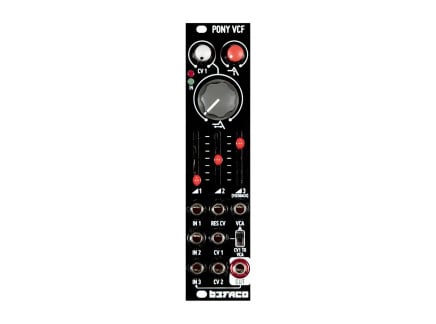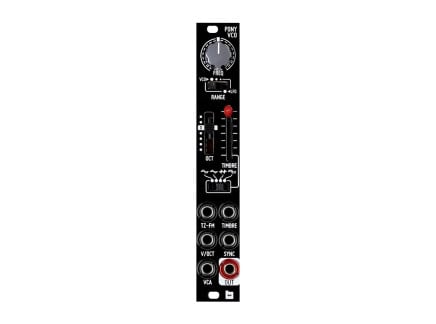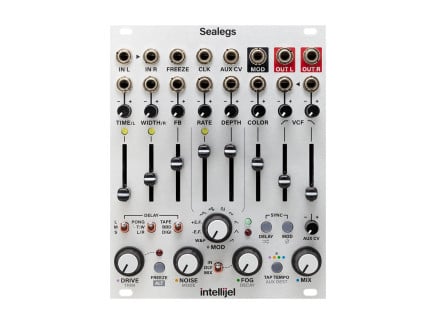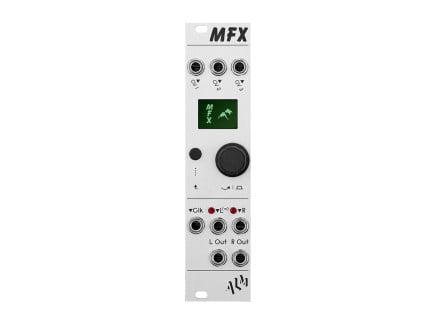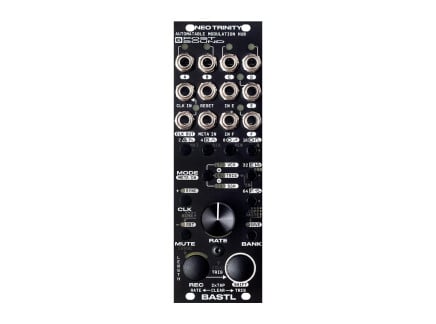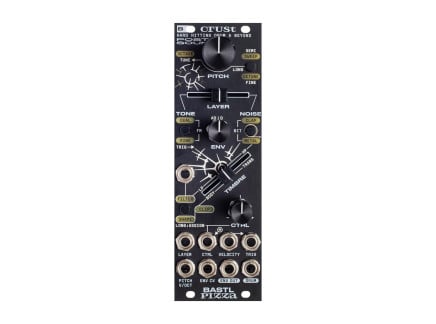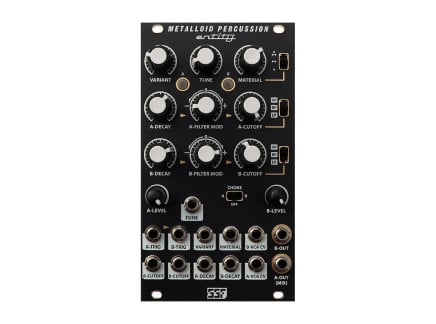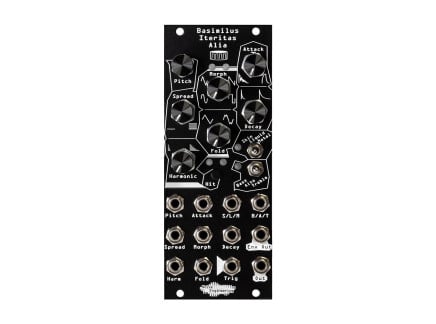Techno. For some, it's a genre of electronic music, while for others, it's a lifestyle more vibrant than any religion. In Germany, Berlin's Techno music scene was added to the UNESCO cultural heritage list as a genre "milestone". They also coined the phrase "Sie sagte Techno oder Sie - Manchmal vermisse ich Sie"—which means "She said Techno or you—sometimes I miss you". You can get that printed on a t-shirt to wear at your local Techno club for dancing to Techno. Techno is a vibe, a beat, a dopamine hit, something that piles its way through any other form of music into that incessant cardio heartbeat that thumps within us all. We hear it, we know it, we move to it.
Given a drum machine, a synth and a crowd, Techno is what we end up with. It's inevitable, like some kind of electronic natural state. Sure, you can get clever with rhythm and tones, explore gateways to cerebral hemorrhages and create wafts of beautiful music; people will love you for it. But give them Techno, and you will be worshipped.
So, at this point, I'm going to attempt to define Techno, which, of course, is an exercise in futility. The nature of what is and is not Techno will be debated long after I'm dead, but I believe there's a way of suggesting some key elements from which Techno tends to emanate. So, let's not get too serious or profound because with a looser grip, we may find a way to build a modular synthesizer setup so that you too, can do Techno.
So What is Techno?
What are the traits of Techno? Techno is about rhythm; it's about 4/4 time, repetitive, repeatable beats. The usual tempo of Techno is an elevated 120–150 BPM. It's not clever or complex; every beat, every kick, snare and hi-hat feels like it's exactly where it needs to be. There are no surprises, just that building inevitability of that deep, deep drop from cliff edge to party. You know it's coming but there's something in the knowing that makes us feel totally alive.
Underneath the tightest drums, you'll usually find a looping, filter-driven bassline around which other elements begin to appear. Simple, complementary synth or piano chords will sometimes punctuate the journey and then in a breath, pads can pour into the space left by a momentary interruption before being sucked into the drop. Simple melodies seem to work the best, with minimal vocal expressions, often captured as samples and fired as accents or points of interest.
Techno is uncomplex, intoxicating, infectious and doesn't require loads of gear to produce. It was forged on second-hand drum machines and half-broken synthesizers, often made by people with little traditional musical skill but who were inspired by the masters of electronic music. There's something about the unpretentious simplicity that grooves it so deeply into our beings. That is Techno.
Building a Modular Techno System
Right, so let's get a bit more specific. What do we need to build our own Techno system? If we stick to the classics, then the drums need to be based around the vintage Roland TR-808 and TR-909 drum machines. You don't need everything—just kick, snare, open and closed hi-hats, and an alternative hit which is usually the clap. The bass should be fat and analog—and was quite often the Roland TB-303 which, of course, is always in danger of spilling us into Acid House. But as a master of Techno we know how to keep things where they need to be. We'll need a couple more synths: one to produce dark and moody pads and another to add stabs and weird arpeggiations. Analog warmth is preferred to digital glassiness, except for when it comes to special effects or accents. And then we'll probably need something to play some samples that will give our Techno a unique flavour or motif.
Techno isn't just a whole bunch of things playing in a loop forever; it's a whole bunch of things playing in a loop forever that are carefully swapped between, muted, unmuted, faded in and out, dropped and regained, lost and found. We will need some control.
When it comes to choosing individual modules, there are many ways to do it, and no one is ever going to agree, which is part of the beauty of modular—it comes down to individual taste. On the one hand you can get entire synths in a single module, or on the other, you can build sounds from component parts. Your path is your own but for the purpose of this article I'm going to attempt to build a Techno system in a single case of about two rows of 104HP.
Drums
We're going to need drums, lots of drums. I'll start with a handful of 909 modules from Tiptop Audio. They will form the reliable bedrock of the beat and offer a few more controls that the originals didn’t possess. Into the case go the SD909 snare drum, the HATS909 and CP909 Clap. For the bass drum I'm going to opt for the Kickain from Knobula. Not only does it contain a decent 909 kick drum, but it's also designed as a side-chaining module that compresses the rest of the track when the kick is triggered. Used subtly, it lets the kick through the mush, or when leant into it can create a fabulous throbbing vibe of sound being pulled in and out that is totally Techno.
If I had the room, I'd consider adding a more exploratory percussion module to work in some weird and wonderful hits. Something like the Winter Plankton ZAPS, the Hexinverter Mutant Machine or Noise Engineering Basimilus Iteritas Alia. If your Techno flavor desires drums over everything else then you can always sacrifice one of the synth voices for this.
To run my rhythms, I flip-flop between wanting something that'll run the whole show, like the Endorphin.es Ground Control, and having something smaller, more playful and experimental. Most Techno is focused and intentional, whereas personally I like to find mine by poking around, like it emerges from the clattering of modular mayhem. And so, I'm going to put in the clock monster of ALM Busy Circuits Pam's Pro Workout to give me clocks, triggers, and modulation that I can use throughout my rack, along with the DNIPRO DOT module that offers three channels of Euclidean and X0X step sequencing.
There are a couple more vital modules to finish off the drum section. First of all, I’ll drop the Divkid Mutes between the triggers and the drum modules. Mutes gives me four channels of mute switches that make it super easy to drop trigger patterns in and out without having to fiddle around in the pattern generators themselves. And secondly, we need a sub-mixer for the Tiptop modules. I will unashamedly suggest the Molten Modular Motion Meter. Set in audio mode it gives very clear three-channel mixing with fabulous metering, so you always know what's going on whether the main fader is up or not.
Bassline
I have been thoroughly enjoying the Befaco Pony VCO recently, and it's become a staple in my system. It's compact, has some nice wave shaping and has a built-in VCA which will save you some space. One of the key features for me is the octave switch. It makes it so easy to switch your bassline up to a lead line, completely reworking your harmonic content. Honestly, I would add a second one so you can do some nice fat unison detuning, or offset intervals, or even run one into the other for some thru-zero FM action. Couple it with the Pony VCF and you have your synth voice right there. The Pony VCF is a Moog-style filter with nice saturation and has three inputs, so you can combine your pair of ponies. All we need is an envelope, and the Shakmat Triple Steeple is super snappy, focused on decay and can handle both oscillators and the filter.
As an alternative, I would consider the Winterbloom Caster & Pollux MkII dual oscillator running into the System 80 860 MkII filter. That would bring a very gooey Roland vibe to your case. Or, if you want something more aggressive, then the ThreeTom MS-22 filter could add some pain, or for a bit more versatility, the Squawk Dirty To Me from Endorphin.es has eight filter types to explore.
One option worth having in your synth voice palette is a low pass gate. It's a different approach to the VCF/VCA thing and gives you a very organic and enticing sound. It's a great alternative flavour to move an oscillator to mid set. With two Pony VCOs, you could easily drop one out, repatch it and then fade between the two. LPGs can be very simple and left to their own devices, but I'm opting for the SSF Steady State Gate, which gives me a lot of control over the decay and feel of the resonance.
Alternative Synth
It would be great to have an alternative synth voice in there somewhere. Something that adds a different texture. Modules I'd consider for this include the Qu-Bit Surface, Modbap Osiris, and Expert Sleepers Super Disting. However, I've found the Bastl Instruments Pizza to be particularly good at cutting through in a live situation, and it has some very playable controls.
Sequencing
Again, something like the Ground Control would be able to handle the drums and three channels of sequencing very capably. But, I've opted for some individual sequencing modules because I like the spontaneity of an eight-step sequencer. The Oct Tone from Glasgow Synth Guild is perfect for killer, repetitive basslines. It flies round in a circle with each of the eight steps on display for easy changes and note muting. It has built-in quantization to keep things simple and on the money with all the usual modes and playability you need.
Alongside the Oct Tone, I've added the Turing Machine random voltage generator. It may seem like a less-than-Techno choice, but it brings a beautifully unexpected vibe to your performance. You can keep it under control using a simple quantizer like the SQT from Centrevillage and then play into the scaling and locking of loops.
Chords
Polyphony in modular can be a bit tricky and take up a lot of space if you're trying to do it with multiple oscillators and interval control systems. You could use polyphonic modules like the OXI Instruments Coral, RYK Modular Vector Wave, or Expert Sleepers Disting EX but then you've still got to have a polyphonic MIDI sequencer to run them.
In a compact system, it may be better to opt for sampled chords that you can trigger rather than making them from scratch. The Two of Cups from Endorphin.es is a great space-saving option with two channels of sample playback and eight banks of ten samples. Stick what you need on the SD card, and you are away.
Effects
I need a solid reverb, some options in a multi-effects module and a fun delay to play with. For the reverb I've gone for the Erica Synths Black Stereo Reverb—job done. A multi-effects module gives you a lot of options to work into your set at some point. It may be to add distortion, or perhaps some chorus, or to have a workhorse delay running with something. The Endorphin.es Milky Way is a good option, and so is the MFX from ALM Busy Circuits.
There are a couple of delays that give great results and something interesting to interact with. The Veno Echo from Venus Instruments has two independent sides, cross modulation and reversing to keep things interesting. But for me, the Intellijel Sealegs seems to offer a lot of creative delay in all the right places and is worth giving up 20HP for.
Mixer
For our Techno to work we need to bring it all together into a mixer that will lets us perform. You may need to do a bit of sub-mixing about the place, but you're probably going to need about six channels. For my system, I've already sub-mixed the drums into one channel, the Pony VCOs are another, the Pizza makes three and the Two of Cups completes the line-up. I do have the Steady State Gate that would appreciate its own channel rather than repatching, and the Two of Cups can benefit from two outputs. So, with six channels I can easily fill them and do some repatching to work other things in if needs be.
The MIX BX from Feedback Modules fits the bill nicely. While I'd probably prefer faders, the MIX BX has solid mute switches, two auxiliary sends and a built-in headphone socket. All the channels are mono but if I patch the Sealegs and Erica Reverb to the auxiliaries, then I've got stereo returns on each.
Final Disruptors
I think it’s shaping up into quite a phenomenal Techno machine. But I have a small amount of space left to add a bit of extra carnage. You could think along the lines of modulation modules (which it currently lacks), weird granular effects, LFOs, logic modules to give your patterns a twist or maybe even an additional sound source or alternative filter. It's great to have options.
For me, the Bastl Neo Trinity is the perfect disruptor. It's a modulation hub that has six channels, which can be LFOs, envelopes, or triggers. It has a fabulous ability to record knob movements. You can dial in your own modulations or spinning envelopes and with a bit of finger gymnastics, it can be a sequencer, modulator and drum machine all in one. You could re-think your set halfway through and bash out something completely inspired with this module.
Into my last few HP I'll drop the Bela Gliss. It's a touch strip with far too many hidden powers, but at a basic level, I can patch it into an oscillator and perform it like a screaming guitar solo. Or I can use it to transpose sequences, modulate filters or make things happen. And in Techno, making things happen is what it's all about.
Now, if you excuse me, I have some Techno to make.



